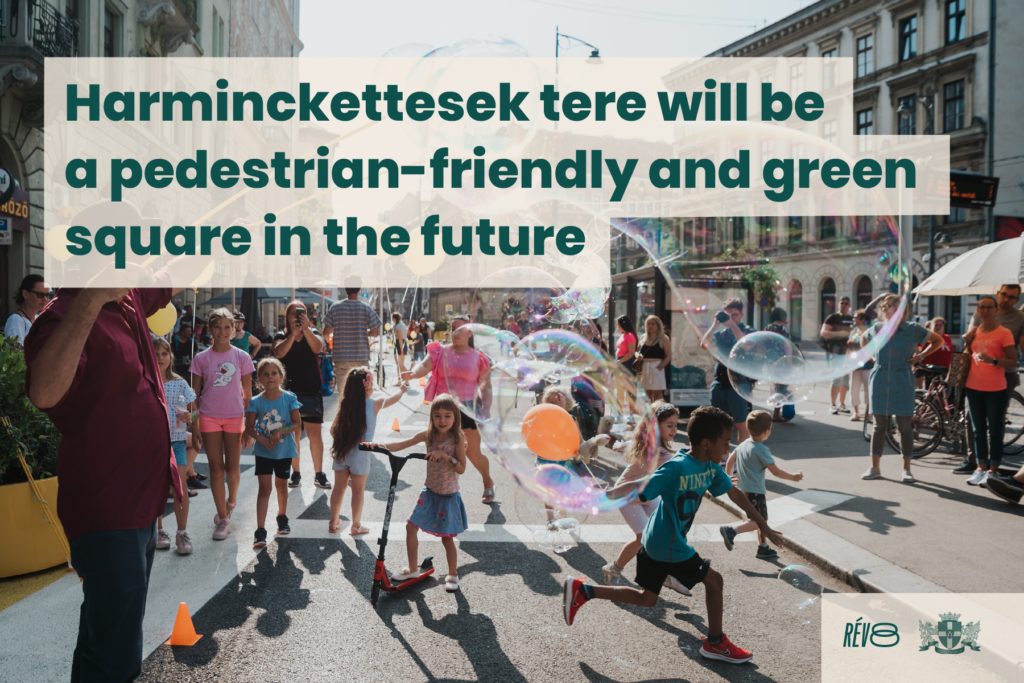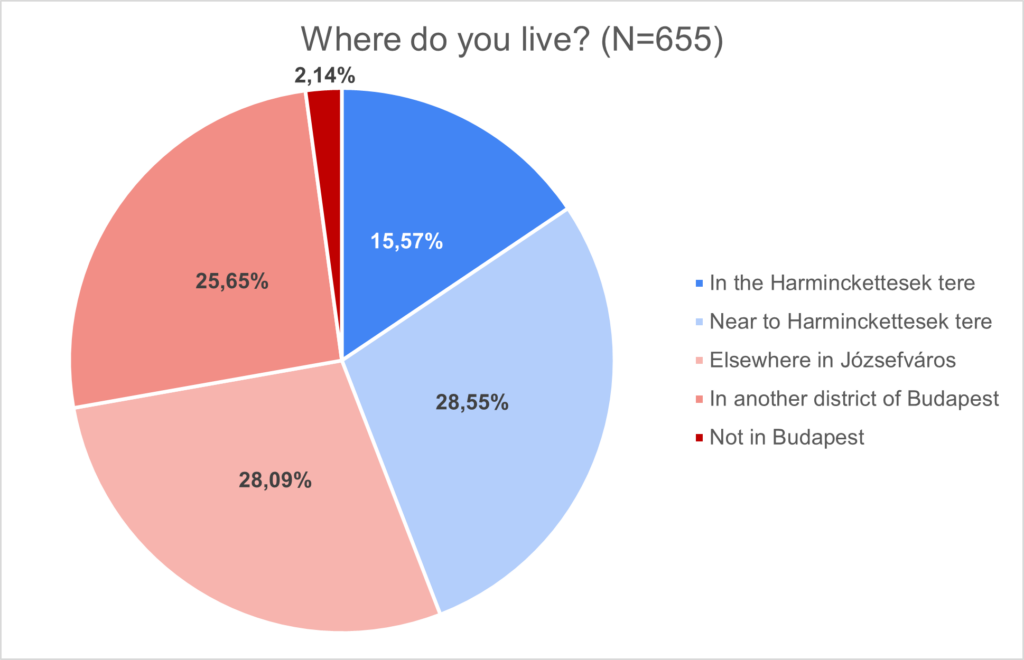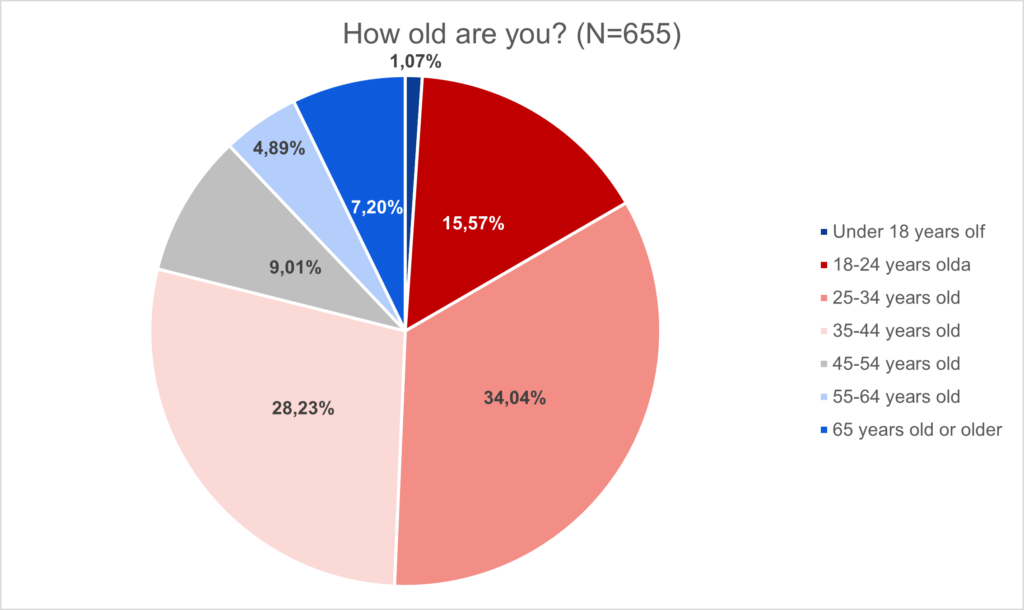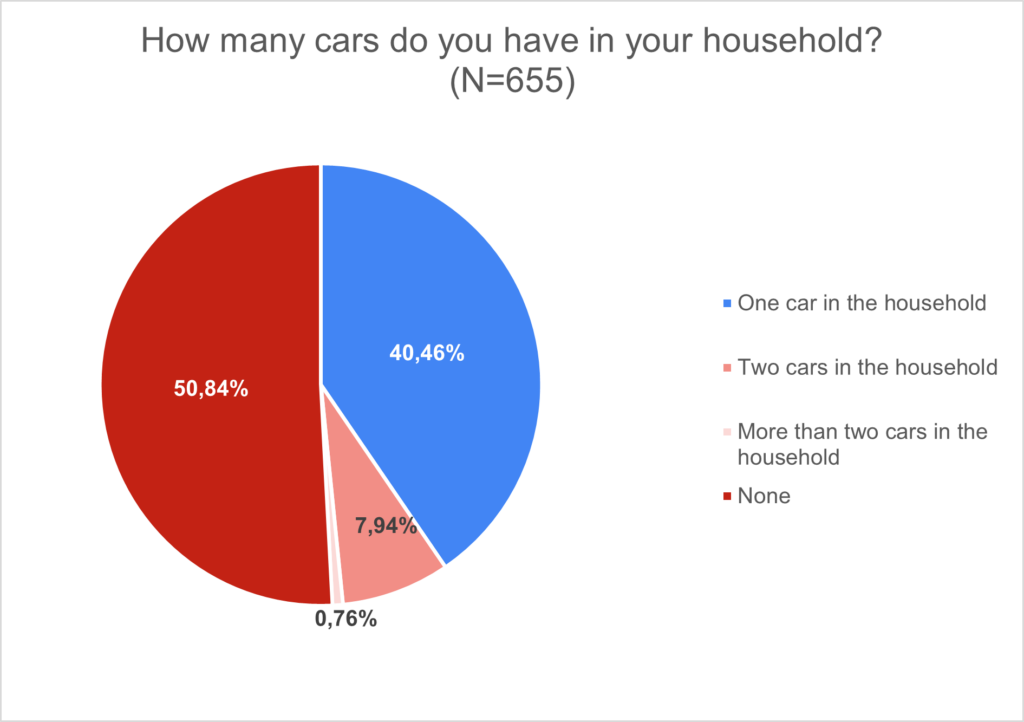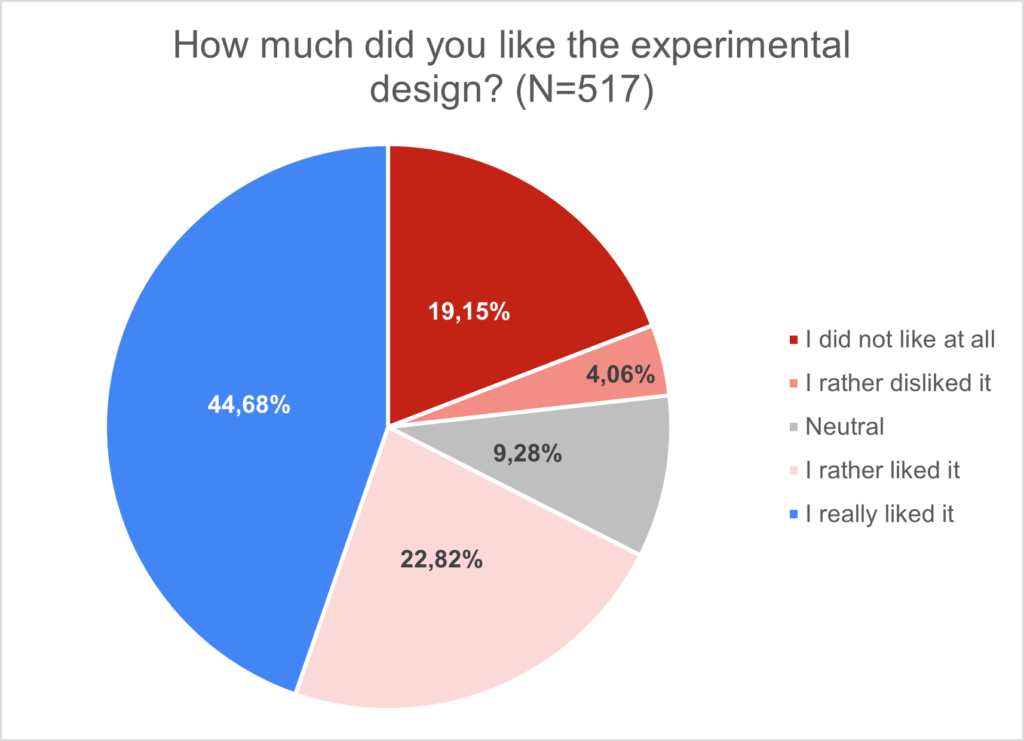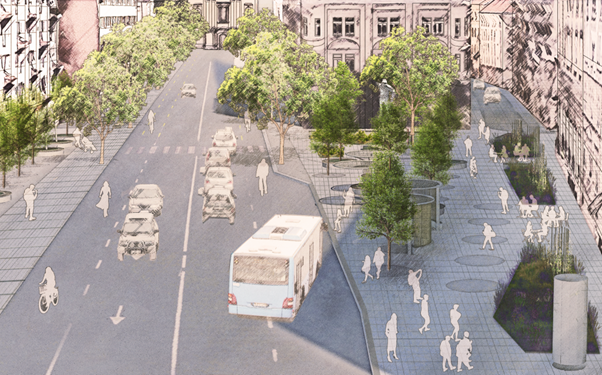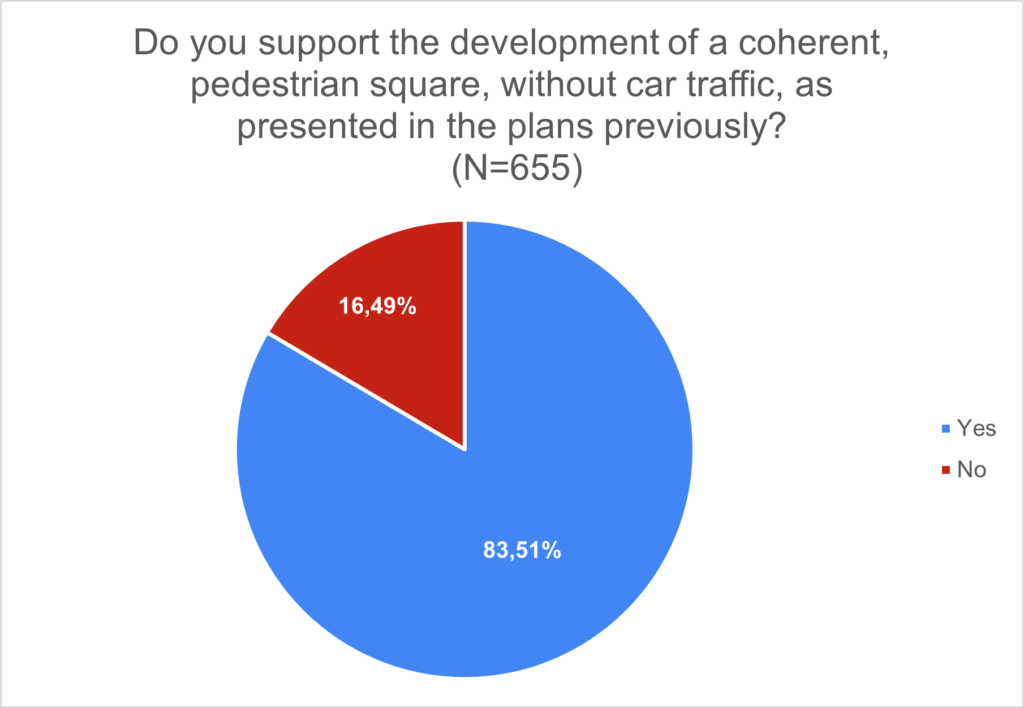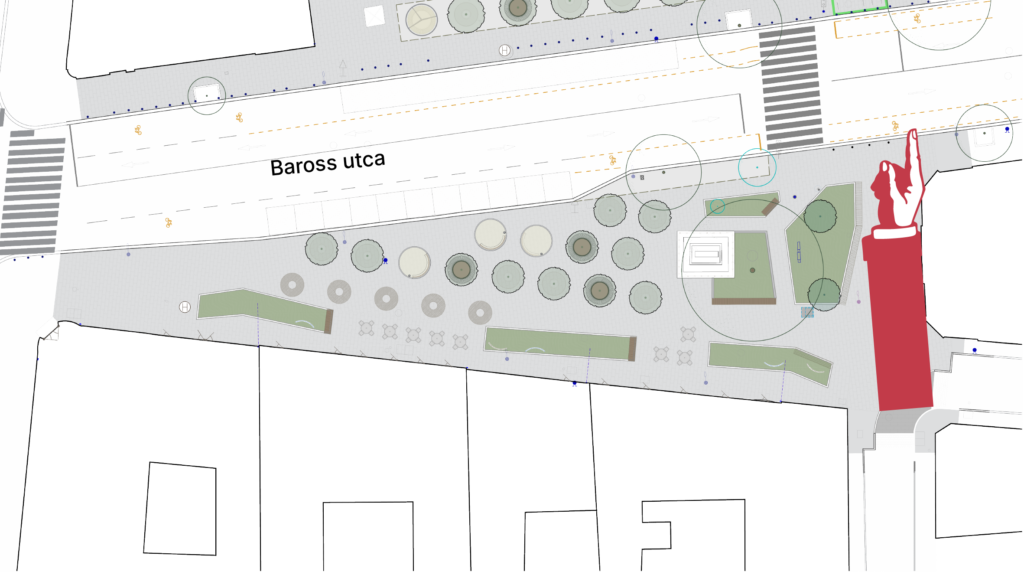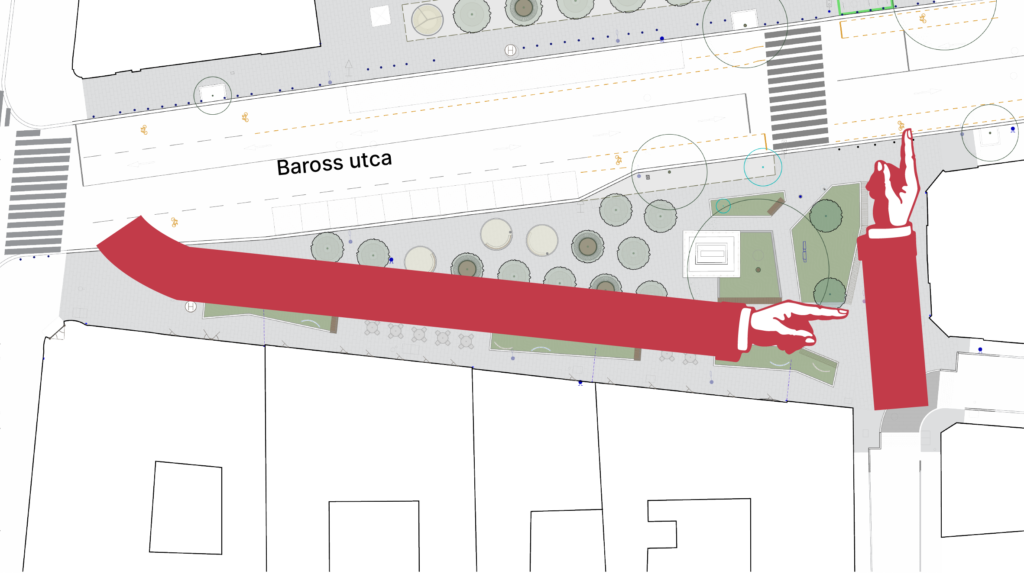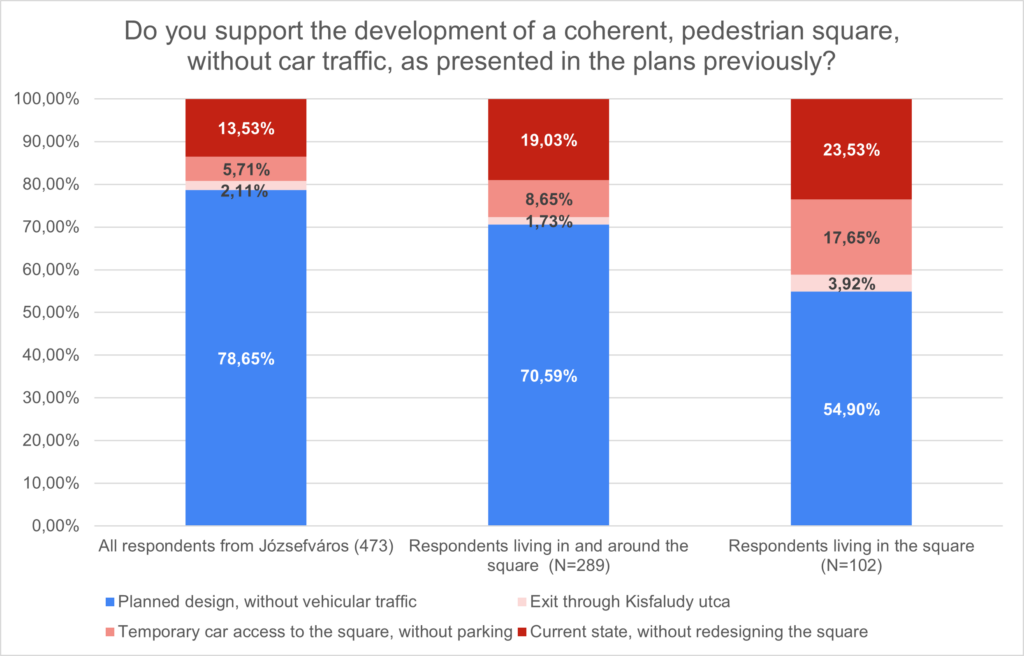We have analyzed the survey about the new plans of the Harminckettesek tere. The majority of respondents support the concept of a coherent, pedestrian square with green solutions. Based on the results, the planning of the square will continue and the received suggestions will be incorporated into the final plans where it’s possible. We want the central square of Józsefváros to be recreated as a green, walkable place, where residents can spend and enjoy their time.
Based on the results, the planning of the Harminckettesek tere continues. The suggestions and needs of the residents were taken into account and a comprehensive study of the traffic order in the Corvin negyed was carried out.
The final plans will be finalised by the planners and the rules for the area will be defined in such a way that the following conditions are met:
- There will be no vehicular traffic on the current service road. However, in certain cases (e.g. delivery of goods, moving, transport of disabled and elderly residents), access to the square will be allowed for a short section from Baross utca and Kis Stáció utca. Vehicles will not be allowed to pass through the square in this case either.
- The opportunity for vehicles to exit the square will be maintained from the Kisfaludy utca to Baross utca, but emphasising the pedestrian character of the square
- No benches will be placed in front of the houses
Why is it important to redesign the Harminckettesek tere?
In the last decades, safe, green, liveable neighbourhoods have been created in Józsefváros, such as the Palotanegyed from Szabó Ervin tér to Mikszáth Kálmán tér and Lőrinc pap tér. This continues with the forthcoming renewal of Krúdy utca. Similar projects can be fund in other parts of the district like Mátyás tér, Corvin Sétány and the recently renovated Horváth Mihály tér.
The main goal of the experimental design and the long term plans for the Harminckettesek tere is to connect the Harminckettesek tere to this pedestrian path.
In summer 2023, we redesigned the Harminckettesek tere with cheap and cost-effective tools to test what works and what doesn’t in the square. After the experimental design we restored the original traffic order and in October 2023, the plans for the square were completed.
How was the survey about the new plans and experimental design carried out?
We asked the residents about the square from 15 November to 15 December 2023. Residents could fill out the survey online and in person with the help of the volunteers from the Municipality of Józsefváros, the staff from RÉV8 Zrt and the Office of Community Participation. We visited the residential buildings in the square and its close neighborhood, where there were 537 apartments in total. 147 of these opened their doors, and where they didn’t open their doors, we left leaflets with the QR-code of the survey.
On 28 November 2023, residents also had the opportunity to see the plans and give their opinions to the Józsefváros Municipality and RÉV8 colleagues, as well as to the designer, at a plan presentation forum. The video of the event can be found here.
Who filled out our survey?
A total of 655 residents answered our questions in the survey, of which 618 (607 in Hungarian and 11 in English) filled out online and 37 in person. The pie chart below shows where the respondents live:
The largest part of the respondents were of active working age, the age distribution can be seen in the graph below:
About half of the respondents own a car, the other half doesn’t have a car.
Questions on the experimental design
Two-thirds of the respondents were either very or very satisfied with the experimental design, and a quarter were critical of it.
- A spatial distribution showed that more than half of the residents of the Harminckettesek tere (52% did not like it at all, 6% did not like it) had a negative opinion on the experimental design, while the residents of Józsefváros were more supportive overall.
- The respondents, who also fulfilled the first part of the survey about the experimental design, 43% used the space every day, 29% several times a week, 15% once a week, 10% monthly and 4% less frequently.
- We asked whether they visited the space more or less often due to the experimental design. Half of the respondents (51%) did not experience any change in the frequency of their use of the space, but interestingly, 30% of respondents visited the space more often in their daily lives, precisely because of the experimental design.
The opinions and suggestions received for the experimental design can be summarised as follows:
- The picnic table, the yellow chairs and tables scattered around the space had lower support than the other solutions.
- A fixed seating solution, similar to Blaha Lujza Square, was also suggested by several respondents as an alternative to movable chairs.
- The problem was raised that the public furniture was often occupied by misbehaving residents who disturbed the peace by their loudness and behaviour.
- The need was raised for regular monitoring and impact assessment of such installations and for the municipality to react quickly to any problems that arise.
If there is a similar project in the district, we will use these experiences during the process.
Support for the new plans
The Municipality of Józsefváros has entrusted OpenSpace Kft. to design the renewal of the Harminckettesek tere. The main goal of the design was to create a coherent, open space that would be more liveable for the residents by increasing the green space and furnishing the square.
- The design not only strengthens the bus stop function of the square, but also provides an opportunity for comfortable waiting and relaxation with unique furnitures and green zones.
- The plan includes as many trees as the public utilities allow. Trees will appear on both sides of the square, in the area in front of the statue and on the other side of the square, across the Baross utca.
- The experimental design has shown that the residents do not want benches in front of their houses, but are happy with the green areas. The plans therefore include perennial beds in front of the houses and space for terraces.
- The plans propose a unified pedestrian square, but the respondents were also able to decide what they would like to see in the future.
More information about the concept plan is available on the website of the Municipality of Józsefváros and RÉV8 Zrt.
84% of all respondents support the proposed design of the square and 16% are against it.
For those who didn’t support the renewal of the Harminckettesek tere, we offered the following three options for the traffic flow and future of the space.
1. Option: Exit from Kisfaludy, but the service road is a pedestrian zone with no vehicular traffic
2. Option: No vehicular traffic on the current service road. In certain cases (e.g. delivery of goods, moving, transport of disabled and elderly residents), car access to the square is temporary allowed.
3. Option: Current status – car traffic and parking allowed around the square
The distribution of responses by residential groups (all respondents in Józsefváros, residents living in and around the square, and residents living only in the square) is also shown separately. The graph below shows that the support for the plans among those living in the square is also 55%, and 24% are against any intervention in the square.
We examined how support for each option changes depending on whether respondents own a car or not. The majority of respondents who own a car in and around the square (57%) also support a coherent, pedestrian square.
The responses show that the majority of respondents support the plans. It also emerged that the square should be designed to provide some form of access for the car owners living around the square in certain cases (e.g. moving, transport of disabled and elderly residents).
In our survey, residents could also share their suggestions and opinions about the square, and the received suggestions will be incorporated into the final plans where it’s possible:
- Suggestions for the design of the green areas
-
-
- Transparent elements to ensure public safety
- Planted trees instead of planters
- Trellis, shading structures with vertical greenery
- Less paving stones, more green areas
-
- Permanent monitoring of public safety, public cleanliness
- Placing benches only in and around bus stops and ensuring that the bus stop is protected from rain
- Use of benches not suitable for lying down
- Proposals for additional street furniture (e.g. drinking fountains, bike racks)
- Solving social problems and taking them into consideration during planning
- Ensuring parking for the residents, and the opportunity for delivering goods
- More than half of those living in the square didn’t support the experimental design, while 60% of those living in the direct neighbourhood of the square liked the experimental design. Feedback from this period will also be taken into account for future projects.
Based on the results, the planning of the Harminckettesek tere will continue. The earliest date in which construction can begin – after the necessary management steps – is autumn 2025. Full financial coverage will be provided in the municipality’s 2025 budget. The municipality’s goal is to make the residential parking system as efficient as possible, and a system is currently being prepared that would allow residents to use parking spaces in underground car parks with a significant discount.
Thank you for sharing your opinions and suggestions on the development of the square!
If you want to follow the latest news about the Harminckettesek tere, subscribe to the RÉV8 newletter: https://rev8.hu/hirlevel/For more information, visit: https://rev8.hu/harminckettesektere/.



